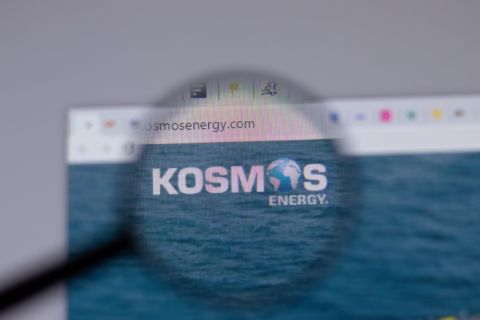Areal-time data collection and transmission configuration integrating a triple-combo suite of harsh-environment LWD sensors with wired drillpipe telemetry is credited with precisely directing well placement to assure optimal fracture placement from the E.ON Ruhrgasoperated Babbage gas field in the North Sea.
The tool string, which included a specially designed crossover sub to interface high-speed real-time LWD and wired pipe data streams, was used in the horizontal intervals of two wells penetrating gas-producing zones within the compartmentalized Babbage reservoir. With analysis of the broadband data ensuring well placement in the sweet spots, the average porosity both wells delivered was orders of magnitude higher than the conventionally drilled B1 well. The economics were optimized further with the use of a motorized rotarysteerable system (RSS) in tandem with continuous monitoring of geosteering data, thereby generating ROP more than three times higher than the offset.
UK’s newest producer
Located in UK Block 48/2a, the Babbage field came onstream in August 2010 and is recognized as one of the largest gas accumulations in the Southern North Sea. First production was from the B3 well. Babbage will produce initially from three predrilled wells, with two production wells planned next year as part of the Phase 2 development. Once the final phase is complete, the platform is expected to produce at its full rate of 247 Mcf/d with a cumulative 177 Bcf of gas to be delivered over its 20-year expected operational life.

The Babbage field contains one of the largest accumulations of natural gas in the Southern North Sea.(Images courtesy of Weatherford International)
The B1 producer was drilled first and would serve as the benchmark offset for the two subsequent wells; it encountered slow drilling and directional problems that resulted in a reservoir section that was shorter than desired. The shorter interval complicated the primary recovery strategy that was to include four evenly spaced hydraulic fracs per well to ensure optimum and even drainage.
The structural challenges intrinsic to the Babbage reservoir extend to the tightly fault-sealed compartments, each requiring individual drainage to ensure maximum recovery. The B1 producer adhered to the initial development plan that stipulated all wells be delivered through conventional data telemetry.
The product of a US Department of Energy and industry-funded joint project, Intellipipe employs a modified swivel to supply wired pipe from the top drive to the top of the bottomhole assembly (BHA) and further down into the LWD, MWD, and rotary steerable tools. Compared to standard mud pulse telemetry, the Intellipipe has the capacity to move considerably more data with an upper limit of about 56,000 bits per second.
Technical challenges overcome
E.ON Ruhrgas was finalizing plans for the B1 well when it decided to examine the possibility of integrating LWD and Intellipipe technologies to expedite return on investment for the subsequent B2 and B3 production wells. Rather than impact the already advanced planning, the operator decided to conventionally drill the B1 as planned and employ wired drillpipe in the two upcoming wells, providing the myriad technical issues could be addressed satisfactorily.

Relative well positions are defined for the Top Leman sandstone.
Chief among the concerns was integrating the large real-time data streams to provide surface access to the data transmitted from downhole. The issue was resolved with the development of a specifically designed crossover sub that would interface the LWD data into the data streaming from the wired drillpipe.
Subjective evidence suggested that the major issue with wired pipe telemetry did not involve its capacity to convey large datasets quickly but rather the risks of overloading conventional surface systems. In conventional telemetry, the surface system only has to handle a large volume of data at memory dump and a continuous stream of real-time pulsing data.
As a contingency, the tool string included a newly designed pulser that would continue to operate should real-time connection with the wired drillpipe be lost.
To facilitate proper placement in the first attempt and expedite the initiation of production, E.ON Ruhrgas elected to deploy an RSS employing point-thebit technology for faster and more responsive steering. The RSS would guide Weatherford’s HEL harsh-environment LWD tool string that would comprise an azimuthal gamma ray sensor to identify the rock types being drilled, a multifrequency resistivity sensor to measure the presence or absence of hydrocarbons, and density/neutron LWD sensors that were designed to provide the clearest images possible to ensure accurate geosteering.

BHA is shown for the E.ON Ruhrgas Babbage field B3 producer.
By setting up a network of real-time observation points both onshore and offshore, geosteering data could be monitored and analyzed 24/7. E.ON Ruhrgas had established a communications protocol whereby geosteering updates were discussed both formally and informally prior to informing the drilling department of proposed trajectory changes indicated by the observations of the geosteering team.
Deploying the technologies
E.ON Ruhrgas targeted the 81?2-in. and 6-in. sections of the two horizontal production wells with the operational objective of drilling the horizontal intervals a minimum of 3,000 ft (915 m) with 2,000 ft (610 m) ideally penetrating the C1 and C2 members of the Leman sandstone. Further, the operator set as a benchmark the delivery of maximum sand footage in an effort to enable four hydraulic fracs per well at 800-ft (244- m) spacing to ensure uniform and optimal drainage from the reservoir.
The two wells maintained extremely high net-to-gross sand footage of 70% and 84%, respectively, for B2z and B3. The ability to pilot the wells accurately was a consequence of the LWD performance, with uptime on the wired drillpipe above 98% for three of the four sections deployed. The porosity, which was considerably higher than the offsets, bodes well for not only the volume of gas in place but also for the permeability, thus promising to speed return on investment through higher production rates.
Further, compared to B1 and the original appraisal well, 48/2a-4, the B2z horizontal producer was drilled at an ROP of 54 ft/hr (16 m/hr), increasing to a high of 63 ft/hr (19 m/hr) for the subsequent B3 well. Unlike the 1,916-ft (584-m) B1 that penetrated into the C1 and C2 sands, the B2z exceeded the planning metrics by drilling 2,118 ft (646 m) into the reservoir, while B3 drilled farther into the production zones to 2,464 ft (751 m).
The clear lines of operator-contractor communication throughout the operation coupled with the use of innovative real-time technologies to increase drilling rates and assure well placement in the targeted sweet spots, and a continuous culture of absorbing lessons learned, has served to raise the bar for future projects.
Recommended Reading
Subsea7 Awarded Sizable Contract in GoM
2024-04-12 - Subsea7 will install a flowline for Talos’ Sunspear development in the Gulf of Mexico.
E&P Highlights: March 4, 2024
2024-03-04 - Here’s a roundup of the latest E&P headlines, including a reserves update and new contract awards.
Texas Earthquake Could Further Restrict Oil Companies' Saltwater Disposal Options
2024-04-12 - The quake was the largest yet in the Stanton Seismic Response Area in the Permian Basin, where regulators were already monitoring seismic activity linked to disposal of saltwater, a natural byproduct of oil and gas production.
Kosmos Energy’s RBL Increased, Maturity Date Extended
2024-04-29 - Kosmos Energy’s reserve-based lending facility’s size has been increased by about 8% to $1.35 billion from $1.25 billion, with current commitments of approximately $1.2 billion.
Pemex Reports Lower 2Q Production, Net Income
2024-05-03 - Mexico’s Pemex reported both lower oil and gas production and a 91% drop in net income in first-quarter 2024, but the company also reduced its total debt to $101.5 billion, executives said during an earnings webcast with analysts.




